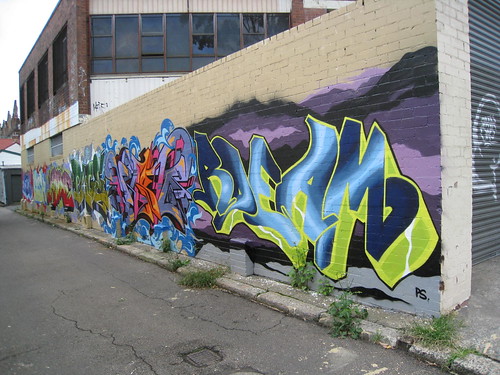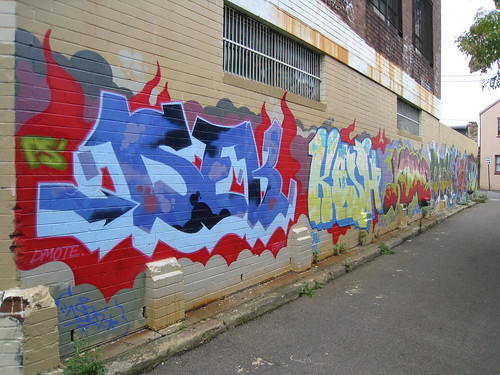What to do about graffiti
British street artist Banksy has become an international phenomenon. But much of the unsolicited street decoration from spray cans and textas is a blight on the environment.
For more than 50 years, perhaps since invention of the aerosol paint can and the texta pen, graffiti has become an urban blight. British street artist Banksy has become an international phenomenon. But much of the unsolicited street decoration from spray cans and textas is a blight on the environment. What can we do about it?
Much of our urban environment is disfigured by graffiti and very many people don’t like it. The matter reached particular prominence in February when an 18-year-old woman was sentenced to three months in jail for tagging a wall on an inner Sydney cafe. Last month her conviction was quashed and she was put on a 12-month good behaviour bond. She had had no previous convictions.
Comment from the state government conservative opposition was (regrettably) predictable. Justice spokesman Greg Smith:
When asked if Back should be behind bars, Mr Smith said: "Personally, I think she should.
"I think graffiti is a very serious offence.
"I understand that the culture hasn’t been to jail and we’ve got to change that culture, otherwise our city is just going to be … an eyesore."
Graffiti tagging can be a dangerous business, as can be easily seen from some of the the locations that boast graffiti tags. My view is that imposing harsh penalties is likely to act as a challenge to the graffitists and there is no penalty if you are never caught. The young woman mentioned above was simply naïve in the game.
If not prison, then can graffiti be stopped?
Indubitably, yes.
A brief paper in the Australian Institute of Criminology Research and Policy Series, No 31, The Promise of Crime Prevention, describes how the New York subway system solved the problem: any car that was tagged was removed from service within two hours and the tag removed. Graffitists, especially those impelled by vandalism rather than subterranean art, move with the times. In recent years graffiti have been scratched into the windows of Sydey suburban trains (possibly using carborundum or scraps of industrial diamonds) and New York vandals have taken to using hydrofluoric acid preparations, which permanently etch the glass in subway car windows.
Even so, rapid removal is a far more effective strategy than threatening to prosecute graffitists. This is especially apparent in comparing the environment in a western suburb of the City of Sydney (where I live) with the adjacent Municipality of Marrickville and whichever government department owns the railway track infrastructure and surrounding land.
The City of Sydney has an aggressive Graffiti Management Policy:
– Removing graffiti from ‘hot spots’ on a daily basis.
– Regular inspections and removal of graffiti every 5 days from the entire Local Government Area.
– Promoting the City Care Line to residents to report graffiti for removal.
– Providing community noticeboards and great opportunities in key areas for the display of community / event information.
CityRail and Marrickville Council do not have such policies but post occasional notices threatening to prosecute offendors (whom they rarely if ever catch).
The City of Sydney process is very effective. The environment is almost always graffiti-free. A key enabler was legislation passed a couple of years ago that permitted Council contractors to paint over graffiti on private property that abutted streets.
In contrast, Marrickville is rather messy although graffitists seem to generally respect private homes and avoid back streets. CityRail property is ugh.
The City of Sydney does provide opportunity for street murals. These are treated the same way as shopkeepers’ signage: they require a Development Application with notification to nearby property occupants of the general tenor of the work.
Sydney accepts street murals done in graffiti-art style, such as this one in Railway Lane, Newtown, viewed from the east, then the west:
Cityrail can sometimes exhibit engaging art, such as this on a noise wall opposite McDonaldtown station:
There is some artistic style behind the three major works, but they are disfigured by the kiddie scribble tags that others have added. I suspect that it is the kiddie scribble with no pretentions to artistic merit that are what most people find most objectionable.
Returning to our 18-year-old, who drew a 30 x 60 cm tag of "2shie" in black texta on a wall at the Hyde Park Cafe after a young man she was with drew an even larger one, if she knew anything about the graffiti business, she would not have done it in the City of Sydney.
Much of the comment on this episode is about punishing wrongdoers with stiffer sentences. The girl’s own grandmother didn’t think a three month jail sentence was harsh enough. But, let’s face it, it’s rare to catch them so harsh sentences don’t make a lot of difference. What does is to destroy their street cred.
"You made a filthy, crazy tag last night? Show us."
"Uh, its seems to have already gone."















unklenelly
June 14, 2011 at 4:36 am
I agree.
yes, a serious matter that needs to be delt with the swiftest of previsions. I i found this hooligan red handed "tagging" on my porch whilst me and my wife were peacefully tucked away.